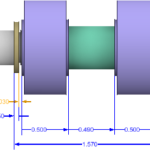A rivet is a short cylindrical bar with a head integral to it. The cylindrical portion of the rivet is called shank or body and lower portion of shank is known as tail, as shown in Fig. The rivets are used to make permanent fastening between the plates such as in structural work, ship building, bridges, tanks and boiler shells. The riveted joints are widely used for joining light metals. The fastenings (i.e. joints) may be classified into the following two groups:
· Permanent fastenings, and
· Temporary or detachable fastenings.
Types of Riveted Joints
Following are the two types of riveted joints, depending upon the way in which the plates are connected.
· Lap joint, and
· Butt joint.
Lap Joint
A lap joint is that in which one plate overlaps the other and the two plates are then riveted together.
Butt Joint
A butt joint is that in which the main plates are kept in alignment butting (i.e. touching) each other and a cover plate (i.e. strap) is placed either on one side or on both sides of the main plates. The cover plate is then riveted together with the main plates. Butt joints are of the following two types:
· Single strap butt joint, and
· Double strap butt joint.
In a single strap butt joint, the edges of the main plates butt against each other and only one cover plate is placed on one side of the main plates and then riveted together.
In a double strap butt joint, the edges of the main plates butt against each other and two cover plates are placed on both sides of the main plates and then riveted together.
In addition to the above, following are the types of riveted joints depending upon the number of rows of the rivets.
Single riveted joint, and
Double riveted joint.

A single riveted joint is that in which there is a single row of rivets in a lap joint as shown in Fig. (a) and there is a single row of rivets on each side in a butt joint as shown in Fig.
A double riveted joint is that in which there are two rows of rivets in a lap joint as shown in Fig. (b) and (c) and there are two rows of rivets on each side in a butt joint as shown in Fig.


Important Terms Used in Riveted Joints
The following terms in connection with the riveted joints are important from the subject point of view :
1. Pitch. It is the distance from the centre of one rivet to the centre of the next rivet measured parallel to the seam as shown in Fig. 9.6. It is usually denoted by p.
Back pitch. It is the perpendicular distance between the centre lines of the successive rows as shown in Fig. It is usually denoted by pb.
Diagonal pitch. It is the distance between the centres of the rivets in adjacent rows of zig-zag riveted joint as shown in Fig. 9.6. It is usually denoted by pd.
Margin or marginal pitch. It is the distance between the centre of rivet hole to the nearest edge of the plate as shown in Fig. 9.6. It is usually denoted by m.


